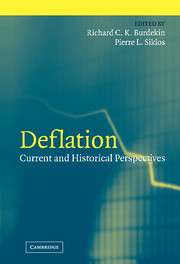Book contents
- Frontmatter
- Contents
- List of Tables and Figures
- List of Contributors
- Preface
- 1 Fears of Deflation and the Role of Monetary Policy: Some Lessons and an Overview
- PART ONE FEARS OF DEFLATION AND THE ROLE OF MONETARY POLICY
- 2 Deflation, Silent Runs, and Bank Holidays in the Great Contraction
- 3 Price Change, Financial Stability, and the British Economy, 1870–1939
- 4 Deflation Dynamics in Sweden: Perceptions, Expectations, and Adjustment During the Deflations of 1921–1923 and 1931–1933
- PART TWO DEFLATION AND ASSET PRICES
- PART THREE INTERNATIONAL PERSPECTIVES ON DEFLATION
- PART FOUR STOCK MARKET ADJUSTMENTS TO DEFLATION
- References
- Index
- Titles in the series
2 - Deflation, Silent Runs, and Bank Holidays in the Great Contraction
Published online by Cambridge University Press: 15 December 2009
- Frontmatter
- Contents
- List of Tables and Figures
- List of Contributors
- Preface
- 1 Fears of Deflation and the Role of Monetary Policy: Some Lessons and an Overview
- PART ONE FEARS OF DEFLATION AND THE ROLE OF MONETARY POLICY
- 2 Deflation, Silent Runs, and Bank Holidays in the Great Contraction
- 3 Price Change, Financial Stability, and the British Economy, 1870–1939
- 4 Deflation Dynamics in Sweden: Perceptions, Expectations, and Adjustment During the Deflations of 1921–1923 and 1931–1933
- PART TWO DEFLATION AND ASSET PRICES
- PART THREE INTERNATIONAL PERSPECTIVES ON DEFLATION
- PART FOUR STOCK MARKET ADJUSTMENTS TO DEFLATION
- References
- Index
- Titles in the series
Summary
SEPARATE REGIONS WITH SEPARATE BANKING SYSTEMS
The Great Contraction of 1929 to 1939, as Friedman and Schwartz (1963) designated it, must surely be the most carefully studied episode in American monetary history. Their work, and that of Kindleberger (1973), Temin (1976, 1989), Eichengreen (1992a), and many other scholars focusing on particular aspects of the contraction, has done much to clarify the causes and consequences of the collapse, and to clarify the policy mistakes made by the Federal Reserve System. Nevertheless, the flood of books and papers on monetary problems during the Depression shows no signs of abating, suggesting that we have not yet reached the point where we believe that existing explanations are entirely sufficient. Moreover, as this is written, the renewed threat of falling prices makes it more important than ever to examine how financial system performance may be affected by deflationary pressures.
Important advances have been made in assessing contagion effects, as opposed to the role of fundamentals, in causing the collapse of a banking system. In this chapter, I will argue that the banking crises of the early 1930s were similar to the “twin crises” – banking and balance of payments crises – that have occurred in developing countries in recent years. The rural regions of the United States were like the developing countries today: dependent on the export of a few commodities in which they had a comparative advantage and with independent and relatively weak banking systems. Declining demand and export prices after 1929 weakened the banking systems in rural regions because they raised doubts about the ability of bank borrowers to repay their loans and led to balance of payments deficits.
- Type
- Chapter
- Information
- DeflationCurrent and Historical Perspectives, pp. 31 - 60Publisher: Cambridge University PressPrint publication year: 2004
- 2
- Cited by



